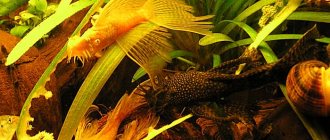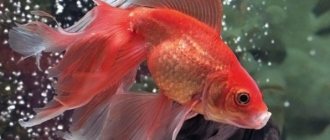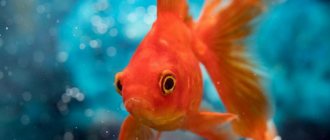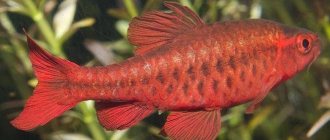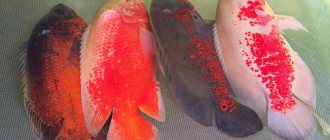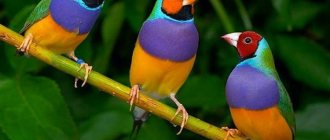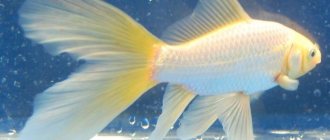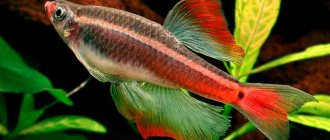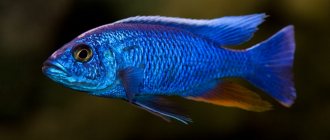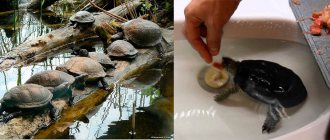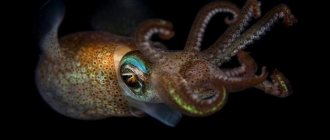Every aquarist has encountered algae along the way. Some used chemicals to combat them, while others bought shrimp, algae eaters, or achieved balance in the aquarium. Fish that scrape off algal fouling include gyrinocheilus (lat. Gyrinocheilus
aymonieri
) or “Chinese algae eater”.
The name comes from the Greek words gyrinos
tadpole and
cheilos
lip. It appeared in home aquariums in the mid-20th century and remains popular among aquarists to this day. In the countries of Southeast Asia, Girinocheilus is a commercial fish.
Description
Girinocheilus belongs to the carp family. Comes from rivers and ponds of Southeast Asia and China. Loves bodies of water with strong currents and a lot of algae and driftwood. In the east it is a commercial fish, which is why in some countries the natural habitats are on the verge of depletion.
Appearance
Golden Gyrinoheylus in nature grows up to 30 cm, and in an aquarium up to 12–15 cm. The body is oblong, slightly arched and flattened on the sides. The gill openings are designed in such a way that they allow the animal not to use its mouth when breathing. The eyes are large, yellow with a black pupil. The mouth is formed by a sucker and a scraper, thanks to which Gyrinocheilus tightly attaches to surfaces and gnaws algae. There are small outgrowths on the muzzle. The algae eater comes in gold, yellow and orange colors. The color can be spotted or plain. The fins are translucent yellow, orange or gray. The tail is forked. The dorsal fin is high and occupies a third of the fish’s body in width.
Behavior
The golden algae eater actively scrapes fouling from stones and glass. As a teenager, Gyrinocheilus is peaceful, but as it matures it becomes territorial and aggressive, especially towards competitors for food. It lives in all layers of water and is diurnal.
Lifespan
With good care, the pet lives for more than 10 years.
Compatibility
Girinocheilus are small, active, diurnal fish that live in all layers of water. They are mainly found at the very bottom or near surfaces from which algae can be cleaned. By nature they are loners.
Young individuals are quite peaceful and calm; they can be kept in common aquariums with other fish, but they must be spacious in order to avoid conflicts with other individuals.
Adults have a harmful character, they become aggressive, zealously defend and guard their territory, and are jealous of food. Cute fish can terrorize weaker relatives to death. It is allowed to keep them in groups of at least 5 pieces. Then the fish build a kind of hierarchy and their level of aggression decreases somewhat.
When choosing neighbors for Girinocheilus, small, peaceful, fast fish that live primarily in the upper layers of water are best suited. Such as botia, barb, catfish corydoras, zebrafish, rasbora and others.
Kinds
Golden Gyrinoheilus are more common in aquariums. Forms with natural colors can be seen less often. Species available for sale are those that are bred on farms rather than those caught in the wild. All species differ only in color, the conditions of detention and character are the same.
Ordinary
Color ranges from yellow to olive with black splashes. The scales are edged with dark.
Siamese
The color is yellow and orange, there may be spots. Not to be confused with the Siamese algae eater - the owner of a longitudinal black stripe on the body and a mouth with a different structure.
Habitat
The first description of the fish appeared in 1883. It was only in 1956 that the algae eater came to Germany and from there spread throughout the world. Nowadays, Gyrinocheilus is not an endangered species, but due to fishing, the number of fish in some countries has decreased significantly.
In nature, it lives in rivers and streams of Vietnam, Cambodia, Thailand, and Laos. The river bottom is strewn with stones, gravel, sand, and also submerged branches. In the habitats of Girinocheilus there is a strong current. The bottom of the rivers is well illuminated by the sun, which has a beneficial effect on the development of algae, which the fish feed on.
Natural look
Content
Golden Gyrinoheilus needs clean water with good aeration and a spacious aquarium.
Aquarium
A 100-liter aquarium is enough for young fish, and 200 liters for an adult fish. When moving, it is necessary to add 30 liters of volume for each individual. Choose an aquarium with a tight lid to prevent the fish from jumping out.
Water parameters
| Water temperature | 22–28 degrees |
| Rigidity | 5–19 dGh |
| Acidity | 6–8 pH |
Aquarium maintenance includes weekly water changes of 20–25%, cleaning the soil with a siphon and washing the decorations.
Plants
Plant any plants you like in an aquarium with golden algae eaters. If there is a sufficient amount of plant food, the fish will not touch even plants with delicate leaves. Plant plants in large numbers to create natural hiding places for fish. Suitable for beginners:
- ferns;
- Anubias;
- cryptocorynes;
- mosses.
View this post on Instagram
Publication from Sergey (@mcloud_14) November 10, 2015 at 5:24 PST
Experienced aquarists can plant more demanding plants:
- water lilies;
- lindernia;
- aciotis;
- ludwigia.
Priming
Fill the bottom with small pebbles and gravel or sandy soil.
Equipment
Equipment you will need:
- Filter. The device must create a flow of water. External filters provide high-quality filtration thanks to a variety of filter materials.
- Compressor. Responsible for supplying oxygen. Choose a powerful device. A lack of oxygen is indicated by the accumulation of aquarium inhabitants in the upper layers of water.
- Heater. The temperature should not fall below 20 degrees, otherwise golden algae eaters will become lethargic and susceptible to disease. When the room is constantly heated, heating is not required. You can cool water in the summer with canisters of frozen water.
Scenery
Algae eaters use grottoes and pots as shelters. Woody driftwood perfectly recreates the natural habitat of golden gyrinocheilus. Place some flat stones at the bottom.
Reproduction
Breeding at home is almost impossible. Golden gyrinocheilus are bred on special farms using hormonal injections. Suitable drugs are expensive and difficult to obtain.
Sex differences
Sex can be determined during the spawning season. Sexual maturity occurs at 2–3 years. Females are larger than males, and males acquire a distinct color and a fatty tubercle appears on the head.
Spawning
Set up a spawning area in a 200-liter container. Lay a net on the bottom to protect the eggs. Take care of high-quality filtration and aeration, plant a large number of plants. Provide moderate lighting. Water parameters for spawning:
| Temperature | 24 degrees |
| Rigidity | 4–5 dGh |
| Acidity | 6.8 pH |
Perform daily water changes of up to 10%. Before spawning, give the female a hormonal injection, as well as during planting and after breeding. Place a female and 1-2 males with a spawning tank. Females lay 3–4 thousand eggs. After spawning, remove the spawners. Remove whitened eggs. Incubation time: 1–2 days. Suitable starter feeds:
- "living dust";
- crushed food for adults;
- boiled egg yolk.
Breeding Gyrinocheilus
Breeding at home is almost impossible, but there is still a chance. Girinocheilus reaches sexual maturity in the second year of life. For breeding, you need a spawning aquarium with a volume of at least 200 liters, at the bottom there is a separator mesh, in the corner of the aquarium there is a filter that creates an average flow of water. It is better to set the current in such a way that when the fish spawns, it lays eggs and they stick to different parts of the spawning ground and are doused with the current. Also, the necessary conditions for spawning should be good aeration and average lighting of the aquarium. It’s good if you also plant aquarium plants in the spawning tank, especially those with large leaves. For spawning they take a female with a full belly and two males. A mature female is capable of laying up to 3000-4000 eggs. For breeding, hormonal injections are used to the female, before spawning for the first time and during landing for spawning - for the second time.
Water parameters for dilution: temperature 24°C, hardness (dH) 4-5°, acidity (pH) 6.8. We do daily water changes up to 10% of the volume of the spawning tank.
The incubation period lasts from 24 to 48 hours. After spawning, we remove the female and monitor the males so that they do not eat the eggs. After fertilization and the appearance of the larvae, we also remove the males from the spawning tank, or we transfer healthy eggs to the hatchery. We make sure that there are no dead eggs in the spawning tank; they have a white coating.
As a starter feed for hyrinocheilus fry, we use crushed plant food, live dust, and egg yolk, and after a week we begin to feed brine shrimp and rotifers.
Important! The most important thing is to keep the spawning tank clean, because... eggs and offspring are very sensitive to viruses and bacteria, so it is recommended to add methylene blue to the hatchery.
Diseases
Diseases appear due to contamination and deviations from the necessary conditions of detention:
- Overfeeding fish leads to obesity, which causes bloating. Follow the feeding schedule, serve food in small pieces and take care of a varied diet.
- The golden algae eater can be poisoned by nitrogen compounds or experience oxygen deprivation if the water is polluted. Check nitrite and ammonia levels periodically with tests. If there is an excess of harmful compounds, replace a quarter of the volume of water, add conditioners that neutralize chemical compounds.
- Girinocheilus aureus also faces infectious and parasitic diseases. Signs: ruffled scales, pale color, loss of appetite, prolonged stay in shelters, lethargy, plaque on the body. Experts will help you determine what disease your fish has. Medicines are sold in pet stores; broad-spectrum antibacterial drugs are also used.
Reviews
Each fish has an individual character. Some have encountered the aggressive nature of Gyrinocheilus and lost smaller pets, while others are delighted with the hardworking aquarium cleaner.
Photo gallery
Adviсe
- If golden algae eaters are seen eating higher plants, adjust the diet. Most likely, they lack plant components. Damage to the scales of pets living in the neighborhood indicates a lack of live food.
- To ensure that Girinocheilus always has plant nutrition, take some plants and stones and put them in a separate container with water. Place a vessel with water in a sunny area - you will provide the fish with algae.
- Remember that a large aquarium must be placed on a sturdy stand.
- Count and inspect your fish daily during feeding.
Golden Gyrinocheilus is an interesting and useful aquarium fish, suitable for large tanks. Due to problems with neighbors and relatively large size, it is inferior in popularity to some other algae eaters.
Previous
FishUnpretentious and beautiful scarlet barb fish
Next
Golden gourami fish - sunny “bunnies” in the aquarium
Feeding
Gyrinocheilus should be fed mainly with plant food (cereals, scalded lettuce, spinach), or live food (brine shrimp, tubifex, etc.). Food is picked up from the bottom. It is better to use dry food in the form of various tablets for bottom fish, chips, granules, in general, such food that will fall to the bottom of the aquarium.
For juveniles, the healthiest food is plant food.
Important! Girinocheilus are prone to overeating if fed only live food.
